Storm Spinnaker - downwind rig with twin headsails + mainsail
04/12/15 16:45 Filed in: Offshore sailing
Sailing east to west across the Atlantic means following winds almost all the way. On this passage we have just spent the entire 11 days nearly dead downwind. Only when the occasional squall went by did the wind shift even as far as 30 degrees, so to steer our rhumb line course we would have the wind from 150 degrees to 180 degrees dead downwind for the whole way. If you are planning this passage you definitely need to have a good strategy for sailing downwind. Of the 60 boats sailing across the Atlantic with us in the ARC-Plus this year, there were a few who didn't have a good downwind strategy, and all regretted it! It's frustrating to have to sail off at a broad reach, adding so many miles and days to the crossing.
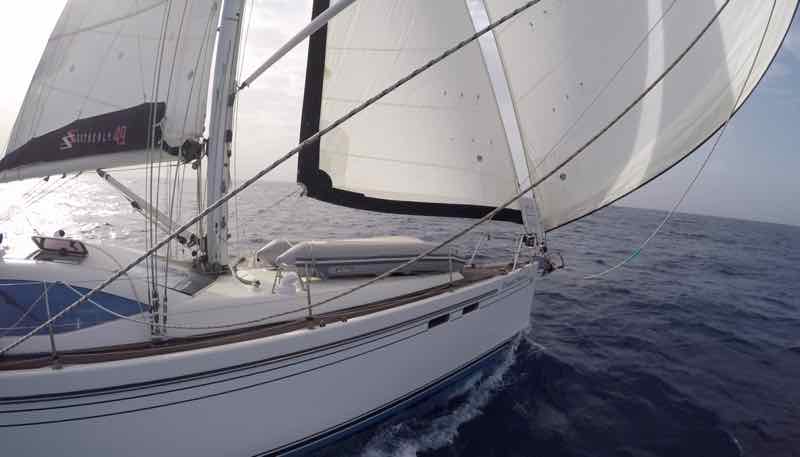
We ran for over 95 percent of the crossing with what we call our "storm spinnaker" and it was very effective! We were near the front of the pack - 9th of 60 boats to finish, and the first monohull under 50 feet. We exceeded our predicted 12-13 days time, finishing in 11 days 7 hours! Whoa!!
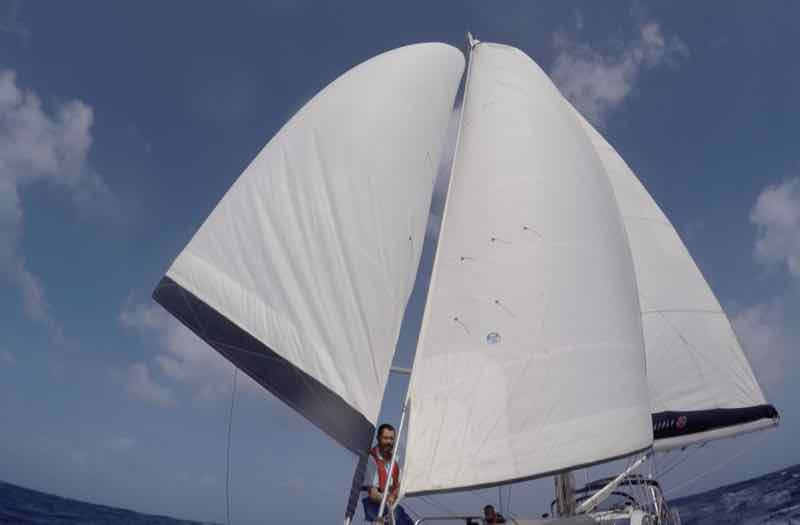
Storm Spinnaker
What's a storm spinnaker? We do not carry an actual spinnaker, but use our two jibs to make our best imitation of a spinnaker shape, poling the genoa out on the windward side and using the smaller jib on the other side in behind the mainsail. Looking at it from the bow you can see the two headsails form a shape nearly the same as a single curved sail.
Twin Headsails
I really like our Solent rig with two headsails on furlers ready to go. But if you don't have that, there are still some possible alternatives to fly twin headsails this way. A "Solent stay" can be added just inboard of the main forestay, and you can hank on a smaller jib. We added this rig to Two-Step many years ago, and it was how we fell in love with the twin headsails. Here is a great article in Sail Magazine that details how best to add a Solent Stay.
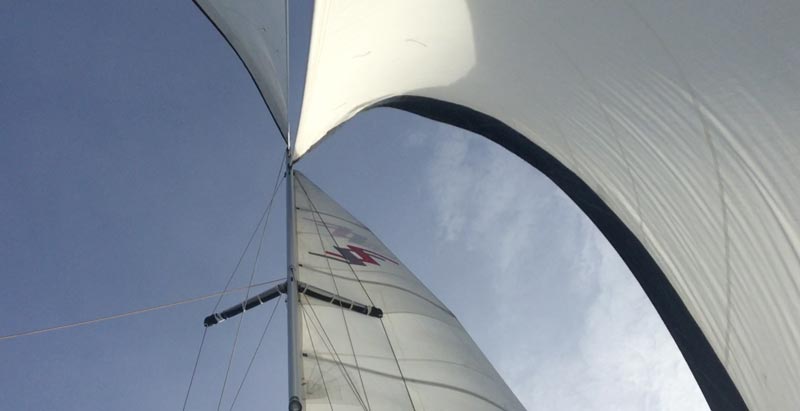
Collapsing Sails?
Sailing nearly downwind we wondered if the smaller jib would be blanketed by the main, and might collapse? After all we were heading 165-175 degrees off the true wind. In the event, we found that by trimming the sails we were able to get maximum speed, comfort and reduced rolling, and the sails didn't collapse. For example, we set our Raymarine Autopilot to steer a relative heading to the wind of 165 degrees. We set the pole and genoa well forward catching as much wind as we could. But between the main (to port) and the genoa (on starboard) there is still as gap. So we set the second jib to catch that wind, making the two jibs look somewhat like a spinnaker. We found it worked best if the smaller jib was sheeted in a quite a bit tighter. It will both help catch the wind, and stop the rolling motion in the big Atlantic swells. In the picture below you can see the jib (on the right of the photo) is sheeted well in.
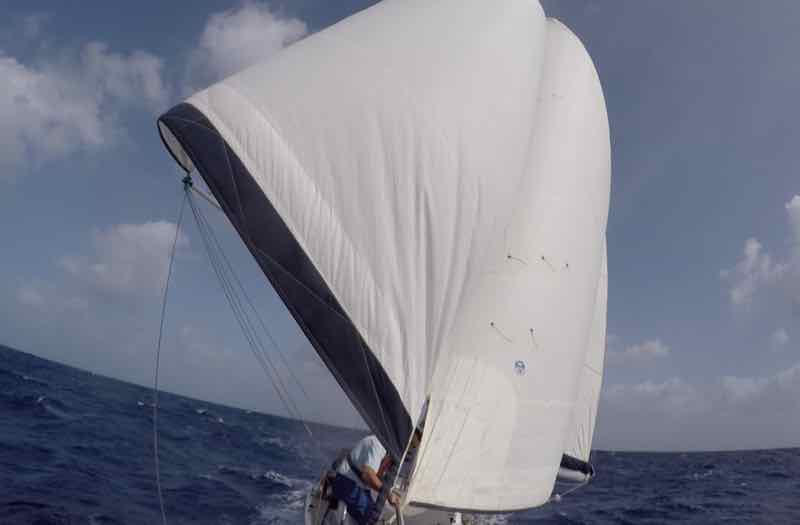
What about a real Spinnaker?
Certainly this can come in handy - but almost all will take down the spinnaker at night, and overall I would estimate they were flown by most boats for just 1-2 days. We had our rig up for the entire time! Spinnakers are a great option, but first of all I would recommend a good setup for poling out the genoa and running the main in a wing-and wing configuration.
Reefable
Our two jibs are on independent Furled furlers, which means we can reef in a little or a lot very easily. We left the furling line for the larger genoa on the winch, and even at night one of us on watch could reef down in seconds if a squall came up. When gusts came up to 30 knots we found we were fine with just a 20-30 percent reduction to the genoa. Any higher and we would reef up the jib a bit. We also were heading downwind so a true wind of 30 was barely 21 or so relative to our downwind course.
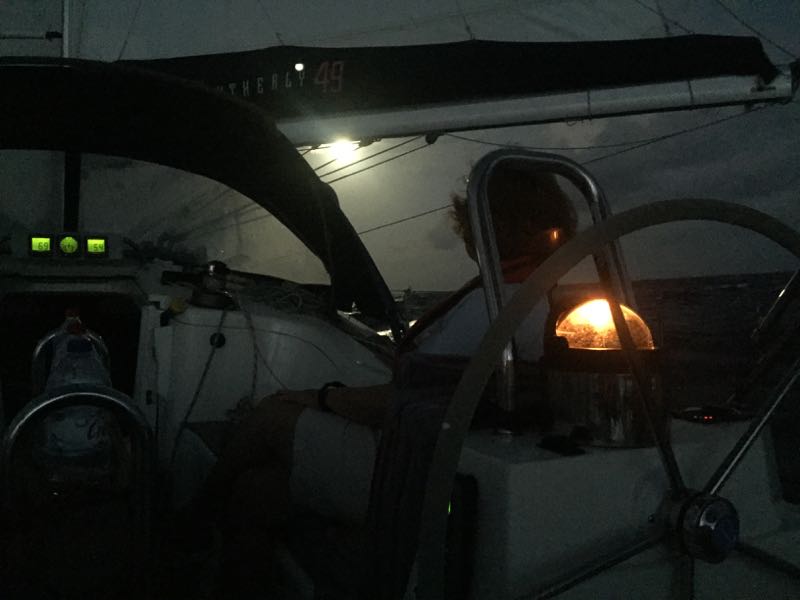
Lock the Downwind Pole in Place
Whenever we use the downwind pole we make sure its locked in place. We rig up 3 lines to the outer pole end…
1) Topping lift - pole height is adjusted by a topping lift to the outer pole end
2) Foreguy - this line is permanently rigged on the foredeck and runs back to the cockpit. When we need it we run it to the pole end to hold it forward.
3) Afterguy - we run the third line from the pole aft to a midships cleat
With these three line the pole end is completely controllable and held in place. If we need to reef the jib away we can just reef the sail in leaving the pole out in position. No worries!
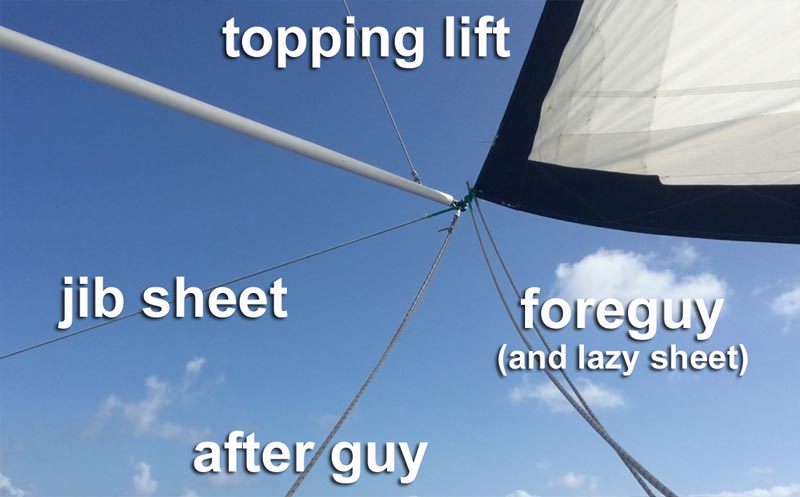
Main Boom Preventer
Running downwind we have the main boom all the way out … and ran a preventer to stop accidental jibes. This means we ran a line from the very end of the boom forward to the bow so the boom couldn't swing across if the wind got behind the sail. In fact it is quite easy for a big wave to push the transom and you find the boat swerving around suddenly heading off 30 degrees… a jibe is all to easy.
We actually had some difficulty with this and the first time we jibed the preventer didn't hold it!! We had a crash jib and broke the mainsheet and traveller cars. What went wrong?
Back when we sailed Two-Step, our Classic 37 cutter, the mast didn't have swept back spreaders. This meant you could put the boom out further, nearly at right angles to the hull, and the angle on the preventer was very effective. Now with many boats like ours having swept-back spreaders you can't get the boom as far forward. See below how the boom on Distant Shores II is not all the way out, and therefore the angle to the bow will mean the preventer must be tight and strong to hold the boom against a jibe.

Our original setup for the preventer was just not tight enough, and had too much stretch in the system. You see it on the right of the photo below running forward and coming over the lifelines, another reason it couldn't be tight enough when rigged this way.
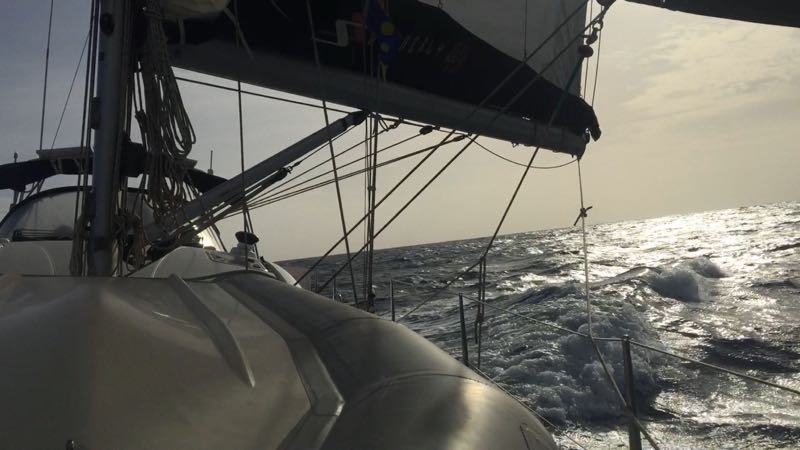
When the wind got behind the main, the preventer held a little, then stretched and the boom swung across anyway. Crash Jibe! Results below as we broke the mainsheet and the two blocks on the traveller.

An Improved Preventer
We carry spare blocks and plenty of rope so in just 15 minutes we were up and sailing again. But we wanted to improve the preventer to guarantee no more jibes. The solution was to use a heavier non-stretch sheet for the preventer, and to bring it back to a cockpit winch so it could be tensioned up.
If your rig is like ours with swept-back spreaders, you might be able to do as we did. Run the preventer forward to the bow around the bow cleat then back to the cockpit on a winch.
Enjoy Downwind Sailing
Whichever rig you choose, gennaker, spinnaker, twin jibs, or something like ours with main and twin jibs, do not overlook the need for a good versatile downwind rig. Especially for the classic trade wind passages you need to be able to do something to catch those lovely warm breezes and enjoy sailing downwind.
blog comments powered by Disqus